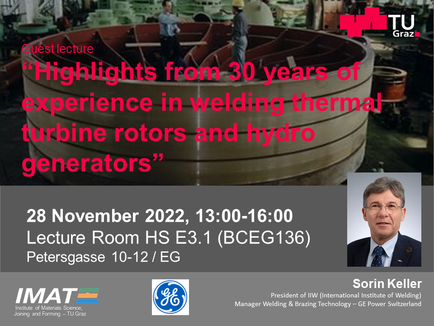Highlights from 30 years of experience in welding thermal turbine rotors and hydro generators
Type
- Vortrag
Topic
- Advanced Materials Science (Field of Expertise)
- Mobility & Production (Field of Expertise)
A characteristic of the gas and steam turbines built since 1929 by BBC or ABB, then ALSTOM and today GE (General Electric), was from the beginning, and still is today, the rotor welded together from individual quenched and tempered forgings. The welding challenge was very high and the welding processes used were an innovation in themselves from the beginning.
30 years of welding experience
Sorin Keller, President of the International Institute of Welding (IIW) gives a retrospective of 30 years of experience in the field of welding. GE has 90 years of experience with welded rotors for steam, gas turbines and turbogenerator rotors. From 1929 to the present, more than 7,800 rotors have been welded together from identical materials or different combinations of materials. At the same time, GE has been involved in the world's largest hydroelectric projects with its hydro turbines and generators.
Future challenges
The future challenge lies in mastering the welding technology on new materials, as well as in further optimizing and rationalizing the welding processes with the aim of increasing the efficiency of the power plants. A further challenge lies in the development and implementation of repair processes that ensure the operation of these machines to a modern environmentally friendly standard, thus making a sustainable contribution to the conservation of resources and the environment.
Host
TU Graz | IMAT – Institute of Materials Science, Joining and Forming
Time and Location
28. November 2022, 08:00 AM - 11:00
TU Graz, Campus Neue Technik, Hörsaal E3.1, Kopernikusgasse 24/I, 8010 Graz
Additional informations
Language: English
Contact
Sandra WESENER
TU Graz | IMAT – Institute of Materials Science, Joining and Forming
sandra.wesener@tugraz.at
Phone: +43 316 873 7181

